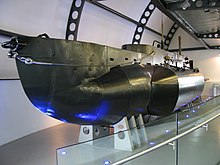X class submarine

X24 on display at the Royal Navy Submarine Museum
|
|
| Class overview | |
|---|---|
| Name: | X class |
| Operators: |
|
| Preceded by: | V class |
| Succeeded by: | XE class |
| Subclasses: | X3, X4, X5-10, X20-25, XT |
| Completed: | 20 |
| Lost: | 7 (5 scuttled, 1 foundered, 1 collision) |
| Preserved: | 1 |
| General characteristics (X class) | |
| Type: | midget submarine |
| Displacement: |
|
| Length: | 51.25 ft (15.62 m) |
| Beam: | 5.75 ft (1.75 m) |
| Draught: | 5.3 ft (1.60 m) |
| Propulsion: |
|
| Speed: |
|
| Range: |
|
| Test depth: | 300 ft (91.5 m) |
| Complement: | 4 |
| Armament: | 2 × 4,400 lb detachable amatol charges |
The X class was a World War II midget submarine class built for the Royal Navy during 1943–44.
Known individually as X-Craft, the vessels were designed to be towed to their intended area of operations by a full-size 'mother' submarine - (usually one of the T class or S class) - with a passage crew on board, the operational crew being transferred from the towing submarine to the X-Craft by dinghy when the operational area was reached, the passage crew returning with the dinghy to the towing submarine. Once the attack was over, the X-Craft would rendezvous with the towing submarine and then be towed home. Range was limited primarily by the endurance and determination of their crews, but was thought to be up to 14 days in the craft or 1,500 miles (2,400 km) distance after suitable training. Actual range of the X-Craft itself was 500 nmi (930 km) surfaced and 82 nmi (152 km) at 2 knots (3.7 km/h) submerged.
The craft was about 51 feet (15.5 m) long, 5.5 feet (1.68 m) in maximum diameter and displaced 27 tons surfaced and 30 tons submerged. Propulsion was by a 4-cylinder Gardner 4LK 42 hp diesel engine, converted from a type used in London buses, and a 30 hp electric motor, giving a maximum surface speed of 6.5 knots (12 km/h), and a submerged speed of 5.5 knots (10.1 km/h). The crew initially numbered three—commander, pilot and ERA (Engine Room Artificer, i.e. engineer) but soon a specialist diver was added, for which an airlock, known as a wet and dry compartment, was provided. The ERA, usually a Navy Chief Petty Officer, operated most of, and maintained all of, the machinery in the vessel.
The weapons on the "X-Craft" were two side-cargoes - explosive charges held on opposite sides of the hull with two tons of amatol in each. The intention was to drop these on the sea bed underneath the target and then escape. The charges were detonated by a time fuse.
...
Wikipedia
